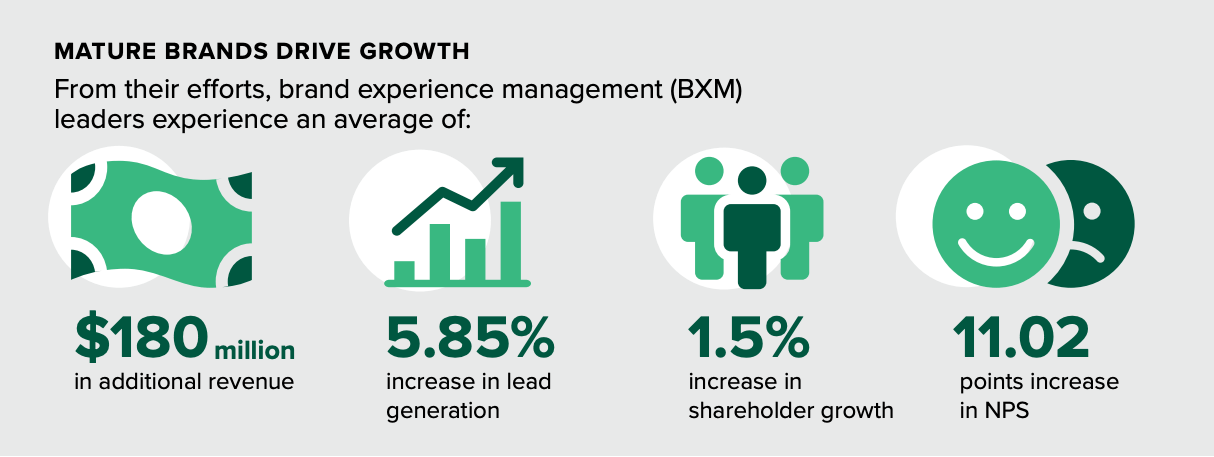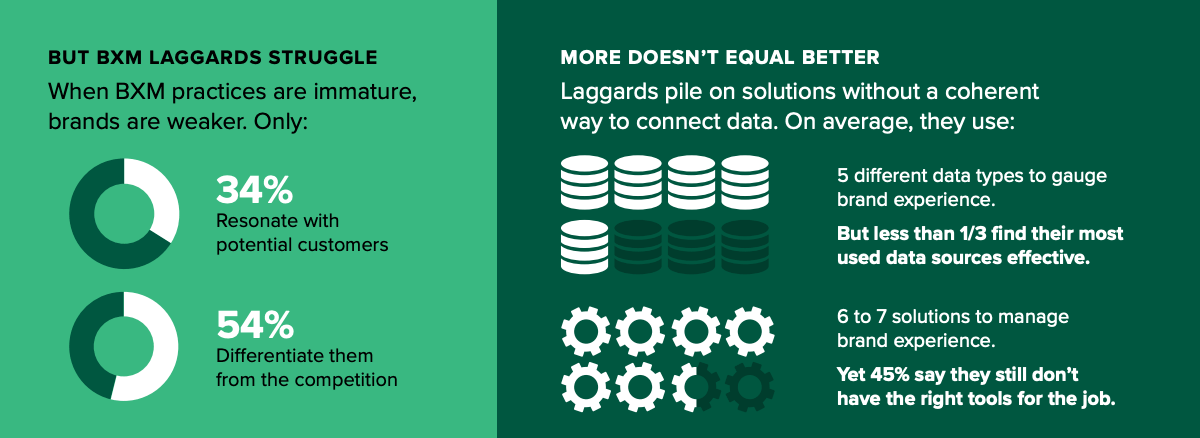Brand Experience
The benefits of a strong brand
After surveying hundreds of global business leaders, a Qualtrics-commissioned study from experienced research firm Forrester Consulting has revealed in-depth benefits of business branding.
Taking insights from 119 global business leaders with high brand experience management maturity and 144 with lower maturity, the October 2020 Forrester Consulting study, The State Of Brand Experience Management, has revealed deeper insights into the financial and reputational benefits of building a strong brand.
Get the benefits of brand experience management by downloading the full study.
From additional revenue to happier customers and shareholders, focusing on experiences that serve to strengthen your brand can be significantly advantageous for your business. Find out more below.
The benefits of creating a strong brand

- An average of $180 million in extra revenue
For the brand leaders with high brand experience management maturity, the financial benefits of solidifying their adopting a brand experience strategy are clear. Respondents invested an average of $105 million in brand experience management, and in return, gained an average of $180 million dollars in additional revenue. Their creation of a recognizable and appealing brand engenders customer loyalty – and continuing profit.
- An average increase of 5.85% in lead generation
With higher levels of brand experience management, business leaders are able to better market themselves to potential leads. Mature brand experience management leaders are 10% more likely to see increased sales revenue, with more effective marketing campaigns and higher conversion rates. By investing in strengthening their brand identity, leaders are able to improve results for multiple areas of business.
- An average 1.5% increase in shareholder growth
Higher profits and better connections to potential and existing customers lead to higher shareholder interest. External brand perception isn’t just for customers – it’s also for those looking to invest in the business. Creating a strong brand with well-established customer recognition and solid marketing strategies is appealing for those looking to invest in the company itself, as well as those who buy products and services.
- An average 11.02 point increased in NPS measurements
Improving metrics like NPS can prove difficult, but customer loyalty, brand awareness, and significant brand differentiation can all be strengthened through brand experience management. With markets and audiences in continuous motion and options ever-increasing, consumers are more empowered than ever to switch between brands. However, respondents to Forrester’s research believe that a thoughtful brand experience management program can go a long way toward making improvements in areas that are key for brand growth – and the results bear out.
The pitfalls to watch out for

- Immature brand experience management practices mean only 34% of brands resonate with potential customers
Respondents are not confident in their brand’s ability to resonate as planned either with their own customers or with potential customers.
Half of all respondents believe that relating brand experience measurement to business outcomes is a key need, but they don’t currently have the capability to do so. As a result, potential business is being lost and resonance falls flat.
- Only 54% of weaker brands can be differentiated from the competition
For leaders, brand experience work is mainly considered a success with existing customer bases, limiting business growth. Building customer loyalty and an emotional connection with new audiences require building differentiation and distinctiveness to grab attention and make a dent in the market. However, without the right tools and marketing strategies, the results aren’t within reach.
- Despite 5 types of data metrics, less than one-third of weaker brands find these sources effective
Surprisingly, the data that is most used as a measurement of brand experience isn’t the most effective. Demographic data, direct response data, and digital media performance data are among the top types of data used by businesses for gauging performance – but in terms of efficacy, customer data, market research data, and shopper/customer journey data are more useful. It’s clear businesses need to consider their brand experience management strategy more carefully to reap the benefits of creating a strong brand.
- 45% of weaker brands say they don’t have the right tools, despite using six or seven solutions
Challenged by issues around having the right tools, accurate performance measurement, and privacy concerns, business leaders managing brand experience are finding it hard to adequately form a brand experience management strategy that is impactful. Despite using multiple tools, more than 40% of respondents lack real-time brand experience management data and insights (45%), predictive analytics (42%), and an automated dashboard for analyzing brand tracker and business data (40%). Their plan to build a strong brand suffers as a result.
How you can reap the benefits of brand experience management

The concept of brand experience management is still considered in its infancy, making now the opportune moment to solidify your brand and its appeal.
From Forrester’s analysis, there are three levels of brand experience management maturity:
1. Highly brand-experience-savvy
There are those businesses that prioritize their brand experience management for better customer and business outcomes.
2. Knows about brand experience, but are more focused on growth
Leaders that are more focused on growing their market presence have work to do in strengthening their brand, but can still leverage their efforts for success.
3. Low brand experience management
Lastly, there are companies that have established their brand in the first instance but haven’t yet created a strong brand identity.
As can be seen in the research, adopting a brand experience strategy mindset and planning accordingly can make a potent difference to your business outcomes. Learning how to take insights from relevant sets of precise experience data, targeting your investment allocations, and using the right tools to track progress toward goals can help to support brand objectives both in the short and long term.
The key recommendations for business leaders looking to implement a brand experience management strategy are:
- Pay close attention to how real customers interact with your brand
- Use the right tools and data to create an effective experience-led brand strategy, rather than becoming overwhelmed with countless data points that create more confusion than action
- Manage customer experience well, but consider brand experience management as an all-encompassing process that creates financial, marketing and customer value
- Measure your efforts effectively and focus on developing what works
- Think long term and consider your potential return on investment – brand experience management is worth the effort
Get the benefits of brand experience management by downloading the full study
